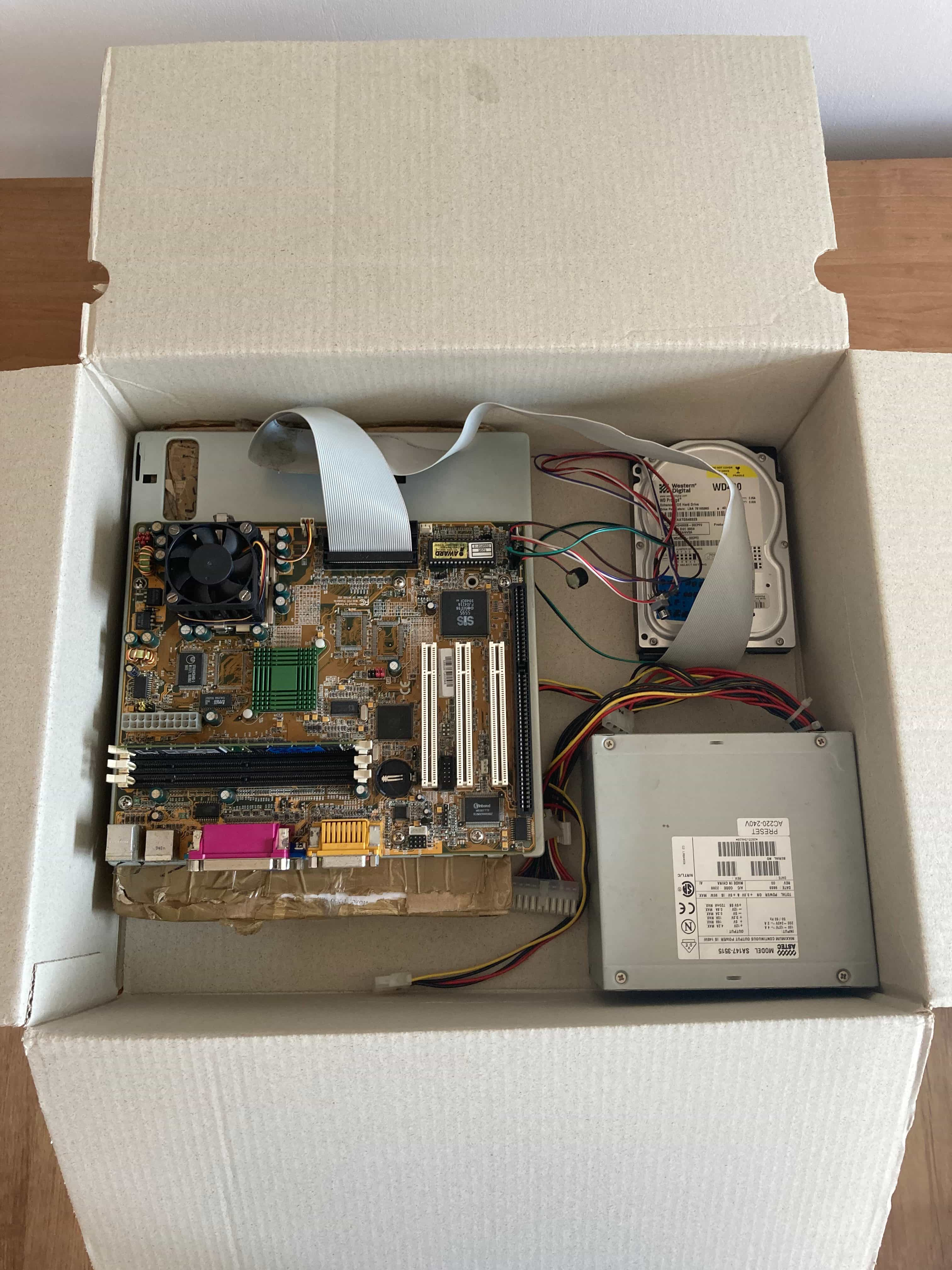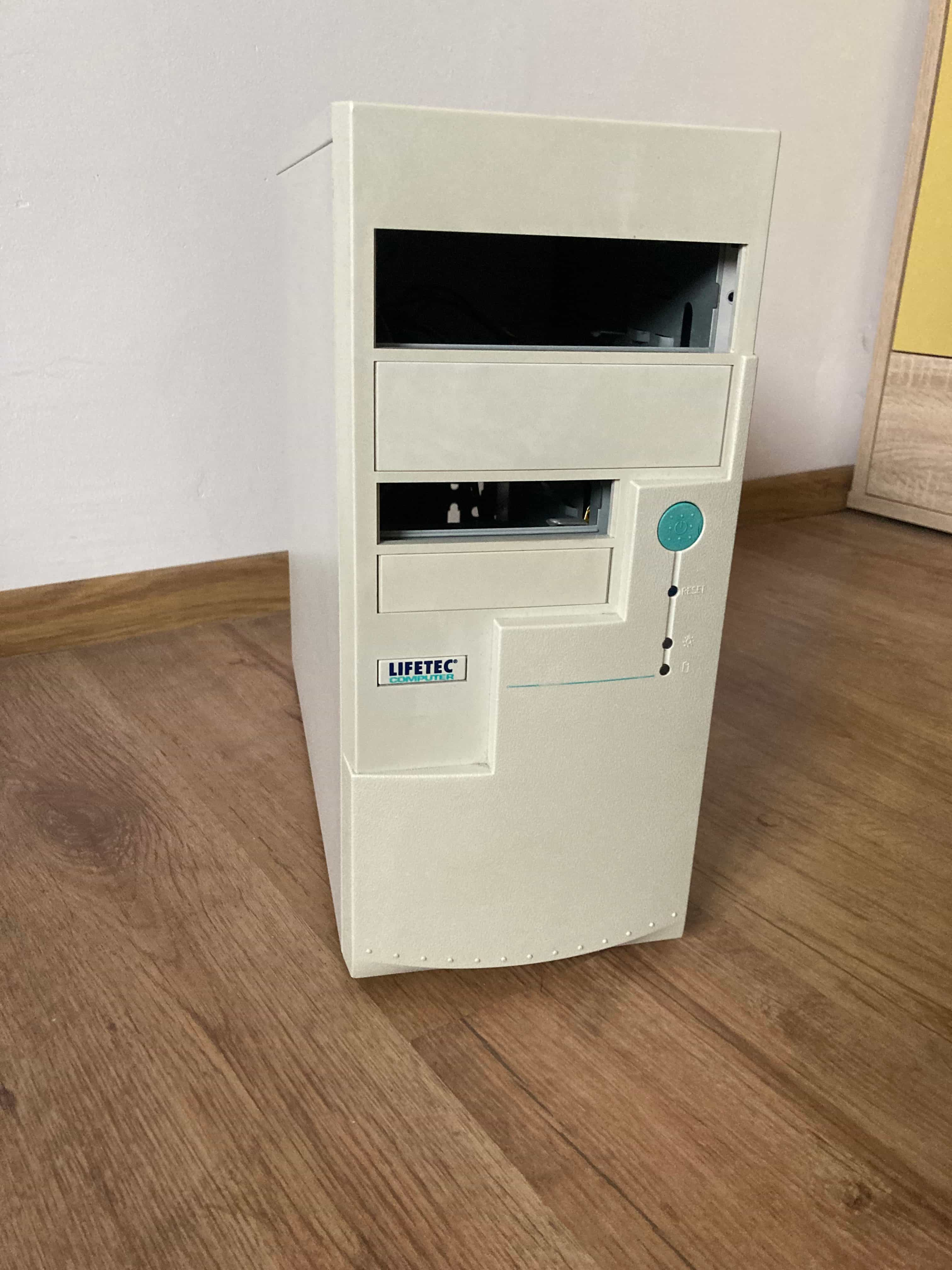
What's in the booooooox?

The "box" the Shuttle HOT-599 was in before. From what I gather online, originally it was a P2/P3 Slot 1 PC.
| Specs | |
|---|---|
| Mobo | Shuttle HOT-599 (Super Socket 7, ATX) |
| Chipset | SiS 5595 |
| CPU | AMD K6-2/300, 300MHz |
| RAM | 128MB SDRAM |
| GPU | Onboard SiS 6326 2D/3D accelerator (under the green heatsink, as SiS 530) |
| Sound | Onboard Yamaha XG YMF752-S |
| Storage | Western Digital WD400 40GB |
| Extras | None (occasionally a POST card) |
| Operating System | Windows 98 SE |
What's up with it?: This is a motherboard that I got for very cheap online (really, pennies). It was a lucky deal, because it also had an AMD K6/2-400 stuck in the CPU socket!! When I got it, initially it did not power on at all, because everything was super dirty - even the insides of the CPU socket! After thorough cleaning it started to POST (by the way - the K6/2 400 was working fine), but the RAM slots are very iffy despite taking extra time and care to clean every nook and cranny. If I swap RAM sticks, it may just stop POSTing and start beeping about a memory error, until randomly it starts working again after countless rebooting and swapping memory sticks. I swapped the CPU for a 300MHz variant and settled on 128MB of RAM for this guy.
It used to live inside a "Lifetec" case pictured on the right, which was bought before the Shuttle board. It originally was a Slot 1 Pentium 2/3 PC. This case is curiously proprietary, and it has little space for a motherboard along with what felt like non-standard slots for brackets. I got rid of the case since.
Integrated hardware: A notable aspect of this motherboard is its rather high - for its time - degree of component integration. Back in '98 or so when this board was released the ATX standard was only starting to gain ground in the market, and most PC users were still content with AT boards. It was also around that time that we began to see PC components being increasingly integrated into the motherboard, i.e video chips (albeit not exactly as a part of a chipset, like here), audio ICs (ES1370s, CMI/Soundpro, Yamaha XG), serial/parallel ports, joystick ports, and the odd USB (which is rather rare as USB was still in diapers when it comes to adoption and support) Integrated components like this were mostly limited to the low-end boards from manufacturers such as Amptron, PCChips, Pine etc. and aimed at frugal buyers, cheap OEMS or small-scale PC shops, whereas people who had any idea about PCs went with separate cards and name-brand boards. They did find their use in the latter market group for their price: a smart and tech-savvy PC user, who might've had an early Socket 7 which did not support SS7 CPUs (or for that matter, even MMX Pentiums) chould upgrade their PC with a cheap motherboard and an AMD CPU as an "interim machine" for the turn of the millenium without mortgaging their house for a then-cutting-edge Pentium II/III system.
Teething tech problems: The biggest headache I had with this board was its stability. Early integrated hardware causes lotsa problems, characterized mainly by things not working fully or not working at all (imagine buying an AGP board only to find out AGP support will be added in a future BIOS patch!); even more so if it's a cheap board like this and not an OEM board from Compaq or whatever (as these generally have their stuff sorted out well). Surprisingly, USB support is an option in the board's BIOS and my pendrives do work with nusb33e (unofficial Win98SE USB patch) but the rest is uh...
DOS game sound support is in my experience very problematic as the Yamaha XG to my knowledge is PCI-only and internally a PCI device. And anyone who had to make a PCI audio card work in DOS knows that it's a doozie. Overall, the integrated audio just has problems. I used many audio drivers which claim to be for this chipset & sound device combo and they either work partly, or break after a few reboots. Ultimately one driver works good enoughTM for me, even if the XG's extra soundbanks don't.
The onboard SiS 6326 works fine, but is no Voodoo 3 and its performance is less than stellar. If you want this board to be part of a retro gaming rig and want to play 3D games from the late-90s era, you're going to want a better GPU. And here's the final kicker: if you look at the image of the board, you'll see it doesn't have an AGP port. And it's a damn shame because finding a capable enough GPU that is compatible enough with software and hardware is a towering task, to say the least. Once AGP hit the market, GPUs almost universally became available in AGP variants. Albeit some video cards were offered both in AGP and PCI flavors - I, for one, had thought about sticking a PCI TNT2/Vanta, PCI Voodoo3 or a PCI Kyro 1, but I simply haven't been able to get any of those cards. Again, it's a damn shame. You might be able to stick in a powerful SS7 CPU, but what's the point if the GPU solution sucks? If I had a PCI Voodoo3, this board would be part of a retro build, but I don't, so it isn't.
Still, if you're looking for an easy touchdown into the world of retro PCs and want to build a mid-90s Pentium 1 PC, this board is a very enticing contender. You don't have to worry about vintage GPU prices, you don't have to bother with fiddly RAM - just stick an SDRAM! - and the sound chip will work for DOS games fine if as long as you run those games from within Windows 9x. And besides all, it's an example of the industry foreshadowing its future with all the integration. In summary, this is a board which is cool on its own merits, even if it's a bit worthless for most people nowadays.
Why is it in a box?: Precisely because of the aforementioned issues. This Shuttle HOT-599 just doesn't "fit" in any of my builds. One parameter can be perfect for a retro PC build, but another will make it unworkable. Where it shines at (for my needs at least) is being a simple testing platform for old hardware and/or software. It supports all S7 and SS7 chips (Pentiums, AMDs, Cyrixes, VIAs and the IDT WinChip), has ISA slots, you can switch the main video output device from the BIOS (perfect for PCI video card testing), the ATX format is very comfortable (How are you gonna do it? Well, you're gonna PS/2 it!), and I can always reinstall Win98, slap on a driver/software package I have prepared, and Bob's your uncle. Rinse, repeat in case I mess anything up. And the box? It's just for convenient storage.
Future plans: I would still like to build a fully-fledged PC with this motherboard, I'm just not sure with what specs. On the one hand, its integrated hardware and SS7 support lend itself to a late low-end Socket 7 machine; on the other, if I had the right PCI graphics card it would be a perfect powerful overclocked K6-2 or K6-3 build. Let me amuse you with hopeful dream specs:
| Dream Specs | |
|---|---|
| Mobo | Shuttle HOT-599 (Super Socket 7, ATX) |
| Chipset | SiS 5595 |
| CPU | AMD K6-2 or K6-III 400/450MHz (ample space in CPU choice here) I would also absolutely OC it, or mod a K6-2 to a K6-III! |
| RAM | 128MB SDRAM |
| GPU | PCI 1: Riva TNT1 / TNT2 / TNT2 M64 PCI 2 + 3: Voodoo 2 12MB SLI (dream specs, after all) |
| Sound | AWE64 Standard or Gold, or some Soundblaster with a Dreamblaster S2 wavetable |
| Storage | Any large-size HDD |
| Extras | None (occasionally a POST card) |
| Operating System | Windows 98 SE |
Sounds amazing on paper, but we would have to learn if the onboard hardware would play nice with all this POWER!! added to the mobo's slots. For now, however, until some other board replaces the Shuttle's job as a testbench, I'm content with its place in my PC hoard.

